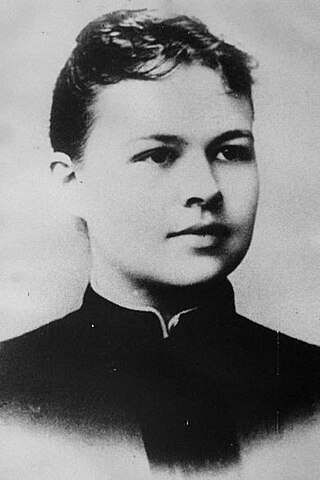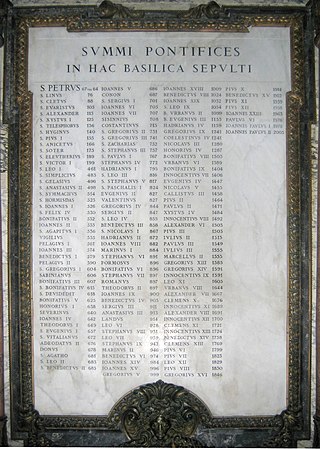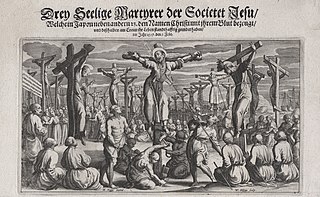Related Research Articles

Canonization is the declaration of a deceased person as an officially recognized saint, specifically, the official act of a Christian communion declaring a person worthy of public veneration and entering their name in the canon catalogue of saints, or authorized list of that communion's recognized saints.

Pope John XXIII, was head of the Catholic Church and sovereign of the Vatican City State from 28 October 1958 until his death in June 1963. He was among 13 children born to Marianna Mazzola and Giovanni Battista Roncalli in a family of sharecroppers who lived in Sotto il Monte, a village in the province of Bergamo, Lombardy. He was ordained to the priesthood on 10 August 1904 and served in a number of posts, as nuncio in France and a delegate to Bulgaria, Greece and Turkey. In a consistory on 12 January 1953 Pope Pius XII made Roncalli a cardinal as the Cardinal-Priest of Santa Prisca in addition to naming him as the Patriarch of Venice. Roncalli was unexpectedly elected pope on 28 October 1958 at age 76 after eleven ballots. Pope John XXIII surprised those who expected him to be a caretaker pope by calling the historic Second Vatican Council (1962–1965), the first session opening on 11 October 1962.

Pope John Paul I was head of the Catholic Church and sovereign of the Vatican City from 26 August 1978 until his death 33 days later. His reign is among the shortest in papal history, resulting in the most recent year of three popes and the first to occur since 1605. John Paul I remains the most recent Italian-born pope, the last in a succession of such popes that started with Clement VII in 1523.

Pope Paul VI was head of the Catholic Church and sovereign of the Vatican City State from 21 June 1963 to his death in August 1978. Succeeding John XXIII, he continued the Second Vatican Council, which he closed in 1965, implementing its numerous reforms. He fostered improved ecumenical relations with Eastern Orthodox and Protestant churches, which resulted in many historic meetings and agreements. In January 1964, he flew to the Hashemite Kingdom of Jordan. This was the first time a reigning pontiff had flown on an airplane, the first papal pilgrimage to the Holy Land, and the first time a Pope had left Italy in more than a century.

Pope Pius V, OP, born Antonio Ghislieri, was head of the Catholic Church and ruler of the Papal States from 7 January 1566 to his death, in May 1572. He is venerated as a saint of the Catholic Church. He is chiefly notable for his role in the Council of Trent, the Counter-Reformation, and the standardization of the Roman Rite within the Latin Church, known as Tridentine mass. Pius V declared Thomas Aquinas a Doctor of the Church.
Pope Liberius was the bishop of Rome from 17 May 352 until his death. According to the Catalogus Liberianus, he was consecrated on 22 May as the successor to Pope Julius I. He is not mentioned as a saint in the Roman Martyrology. That makes him the earliest pontiff not to be venerated as a saint in the Roman Rite and one of only two popes to be omitted from Roman Catholic sainthood in the first 500 years of church history.

A papal coronation is the formal ceremony of the placing of the papal tiara on a newly elected pope. The first recorded papal coronation was of Pope Nicholas I in 858. The most recent was the 1963 coronation of Paul VI, who soon afterwards abandoned the practice of wearing the tiara. To date, none of his successors have used the tiara, and their papal inauguration celebrations have included no coronation ceremony, although any future pope may elect to restore the use of the tiara at any point during his pontificate.

In the Catholic Church, the Dicastery for the Causes of Saints, previously named the Congregation for the Causes of Saints, is the dicastery of the Roman Curia that oversees the complex process that leads to the canonization of saints, passing through the steps of a declaration of "heroic virtues" and beatification. After preparing a case, including the approval of miracles, the case is presented to the pope, who decides whether or not to proceed with beatification or canonization.

Beatification is a recognition accorded by the Catholic Church of a deceased person's entrance into Heaven and capacity to intercede on behalf of individuals who pray in their name. Beati is the plural form, referring to those who have undergone the process of beatification; they possess the title of "Blessed" before their names and are often referred to in English as "a Blessed" or, plurally, "Blesseds".
A papal renunciation also called a papal abdication, occurs when the reigning pope of the Catholic Church voluntarily steps down from his position. As the reign of the pope has conventionally been from election until death, papal renunciation is an uncommon event. Before the 21st century, only five popes unambiguously resigned with historical certainty, all between the 10th and 15th centuries. Additionally, there are disputed claims of four popes having resigned, dating from the 3rd to the 11th centuries; a fifth disputed case may have involved an antipope.

The Forty Martyrs of England and Wales or Cuthbert Mayne and Thirty-Nine Companion Martyrs are a group of Catholic, lay and religious, men and women, executed between 1535 and 1679 for treason and related offences under various laws enacted by Parliament during the English Reformation. The individuals listed range from Carthusian monks who in 1535 declined to accept Henry VIII's Act of Supremacy, to seminary priests who were caught up in the alleged Popish Plot against Charles II in 1679. Many were sentenced to death at show trials, or with no trial at all.

St. John Paul II Catholic Secondary School ; known as Blessed Pope John Paul II Catholic Secondary School and Pope John Paul II Catholic Secondary School before the beatification of John Paul II is a publicly funded high school in Toronto, Ontario, Canada. It serves the West Hill and Seven Oaks neighbourhoods of Scarborough. It is administered by the Toronto Catholic District School Board. The motto for Pope is Laudetur Jesus Christus which translates as "Praised be Jesus Christ".

Maria Elizabeth Hesselblad, OSsS, was a Swedish religious sister who founded a new, active, branch of the Bridgettine order in the Roman Catholic Church, known as the "Bridgettine Sisters". Hesselblad is recognised as a Righteous Among the Nations due to her efforts in World War II saving the lives of Jews during the genocide of the Holocaust.

A papal name or pontificial name is the regnal name taken by a pope. Both the head of the Catholic Church, usually known as the pope, and the pope of the Coptic Orthodox Church of Alexandria choose papal names. As of 2013, Pope Francis is the Catholic pope, and Tawadros II or Theodoros II is the Coptic pope. This article discusses and lists the names of Catholic popes; another article has a list of Coptic Orthodox popes of Alexandria.

The Martyrs of Japan were Christian missionaries and followers who were persecuted and executed, mostly during the Tokugawa shogunate period in the 17th century. More than 400 martyrs of Japan have been recognized with beatification by the Catholic Church, and 42 have been canonized as saints.
John Sandys was an English Roman Catholic priest. He is a Catholic martyr, beatified in 1987, and is commemorated on 11 August.

Pope John Paul II reigned as pope of the Roman Catholic Church and sovereign of the Vatican City State for 26 years from October 1978 to his death, on 2 April 2005. Since his death, many thousands of people have been supporting the case for beatifying and canonising Pope John Paul II as a saint. His formal beatification ceremony took place on 1 May 2011.
The canonization process of Pope Pius XII dates to shortly after his death in 1958. He was declared a servant of God in 1990 and venerable in 2009. Father Peter Gumpel was the relator of Pius XII's cause for canonization. The potential beatification of Pius XII has raised concern, especially by Jewish organisations, because of his controversial record during the Holocaust. The objections especially arise because of the refusal by the Vatican to allow independent access to the Vatican's archives for the period of Pius XII's papacy.
References
- ↑ "Pentin, Edward. "It's Official: John Paul II and John XXIII to Be Canonized April 27", National Catholic Register, Oct 14, 2013". Archived from the original on March 9, 2014. Retrieved October 24, 2013.
- ↑ Kelly, Leo. "Pope St. Deusdedit." The Catholic Encyclopedia Vol. 4. New York: Robert Appleton Company, 1908. April 2, 2016
- ↑ Loughlin, James. "Pope St. Adrian III." The Catholic Encyclopedia Vol. 1. New York: Robert Appleton Company, 1907. April 2, 2016
- ↑ Declaration of the heroic virtue of the servant of God, Paul VI
- ↑ Biography of Bl. Pope Pius IX
- ↑ Webster, Douglas Raymund. "Pope Bl. Urban V." The Catholic Encyclopedia. Vol. 15. New York: Robert Appleton Company, 1912. 13 Feb. 2013
- ↑ Webster, Douglas Raymund. "Pope Blessed Victor III." The Catholic Encyclopedia. Vol. 15. New York: Robert Appleton Company, 1912. 13 Feb. 2013
- ↑ "Pope beatifies John Paul I: May he obtain for us the 'smile of the soul' - Vatican News". September 4, 2022.
- ↑ "Miranda, Salvador. "Orsini, O.P., Vincenzo Maria", Cardinals of the Holy Roman Church, August 18, 2015". Archived from the original on January 18, 2012. Retrieved August 28, 2017.